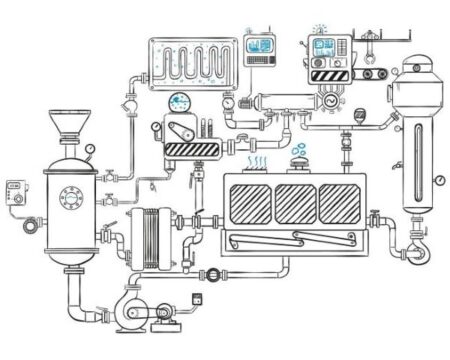If you've ever used a pneumatic tool or seen a piece of heavy machinery in action, you've probably witnessed the power of pneumatic systems. These systems rely on compressed air to drive pistons, motors, and other mechanical components, making them an essential part of many industrial and manufacturing processes.
But what exactly goes into a pneumatic system? In this blog, we'll take a closer look at the 8 major pneumatic system components and their functions, giving you a better understanding of how these systems work and what you need to keep them running smoothly.
1. Compressor
The compressor is the essential component of a pneumatic system, responsible for pressurizing the air needed to operate the system. When air is compressed, its volume decreases, resulting in increased pressure. This pressure can then be used to power machines.
Compressors come in many shapes and sizes, but all work by compressing atmospheric air and storing it in a tank or reservoir. The compressed air can then be used to power pneumatic tools or other components.
2. Air Treatment Components (FRL Combination)
Another essential pneumatic component is the air treatment unit. The air coming out of the compressor is usually hot, dirty, and filled with moisture. That's why pneumatic systems typically include air treatment components, such as filters, regulators, and lubricators, which are combined in an FRL unit. The FRL combination removes impurities, regulates air pressure, and lubricates moving parts to ensure smooth operation.
3. Directional Control Valves
Pneumatic directional control valves are a crucial component of pneumatic systems, responsible for controlling the flow and direction of compressed air. These valves enable pneumatic systems to perform various tasks accurately and efficiently. They can be manually operated or activated by solenoids. Depending on their intended use, pneumatic control valves can be single or double-acting. Single-acting valves control the motion of single-acting pneumatic actuators that move in only one direction, while double-acting valves control the movement of double-acting pneumatic actuators that move in two directions.
4. Solenoid Valves
The next important pneumatic component is solenoid valves, which are electromechanical devices that employ a solenoid to manage the flow of gas or fluid.
Solenoid valves are used in a broad range of applications, including managing airflow in pneumatic systems and in industrial applications such as control systems, door lock mechanisms, hydraulic systems, and more. A solenoid works by using magnetic force to control the flow of fluid or gas.
5. Pneumatic Fittings
Pneumatic fittings are the connectors of a pneumatic system, allowing components to be joined together and air to flow between them. Pneumatic systems rely on pneumatic fittings to connect various components, such as hoses, pipes, and tubes, and ensure their efficient and safe operation. Without these fittings, the entire system would fail to function properly.
6. Pneumatic Cylinders
Pneumatic cylinders, also called air cylinders or pneumatic actuators, use compressed gas to create force or motion. Pneumatic cylinders are simple to install, lightweight, and have low maintenance requirements, making them a prevalent choice in industrial applications. They come in different sizes and types to meet diverse application requirements.
7. Air Reservoir
An air reservoir tank, also known as an air receiver, is a container used to store compressed air that is generated by the compressor. The tank acts as a buffer, providing a reserve of compressed air that can be used during times of high demand or when the compressor is not running.
8. Pneumatic Circuit
A pneumatic circuit is a system that uses compressed air to control mechanical motion. It consists of various pneumatic components, such as compressors, cylinders, valves, and filters, that work together to produce the desired movement or action. The components are connected by pipes or tubing that transport compressed air to each component. The air pressure and flow are regulated by control valves that open and close to control the direction and amount of airflow.
The Importance of Pneumatic Components
Pneumatic components are essential in various industries and applications where the efficient control and transfer of compressed air or gases are required. The importance of pneumatic components includes the following:
- Automation: Pneumatic components are widely used in automation, where they are used to control the movement of machines and equipment. They offer fast and accurate motion, making them ideal for applications where speed and precision are critical.
- Cost-effective: Compared to other power sources, such as hydraulic or electrical systems, pneumatic systems are generally more cost-effective. The components are relatively inexpensive, and the compressed air used as the power source is readily available and affordable.
- Safe to use: Pneumatic systems are safe to use, as they do not involve electrical power or flammable liquids. They are also relatively quiet, producing minimal noise pollution.
- Easy to maintain: Pneumatic components are easy to maintain, as they have fewer moving parts than hydraulic or electrical systems. They also require less frequent maintenance, resulting in lower maintenance costs and downtime.
- Versatility: Pneumatic components are highly versatile and can be used in a wide range of applications. They can be easily integrated into existing systems and can be adapted to suit different requirements.
Understanding these components is key to building and maintaining a pneumatic system. For quality pneumatic components, check out HAK Pneumatic, a high-quality pneumatic tools supplier. With the right pneumatic components and a bit of know-how, you can harness the power of compressed air to drive your manufacturing process to the next level.

